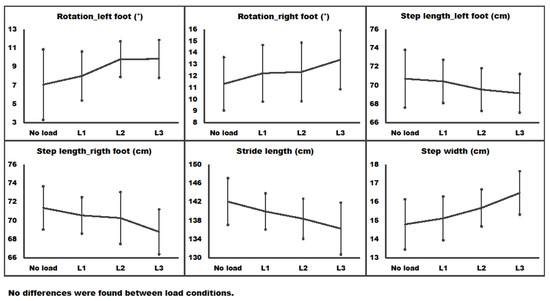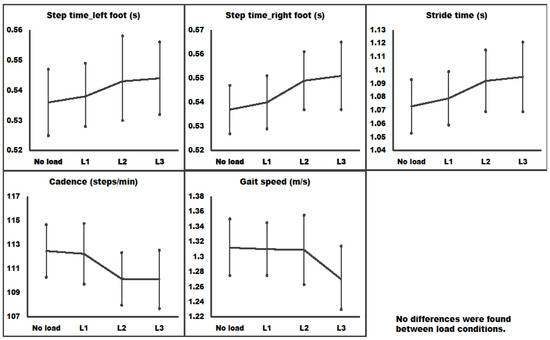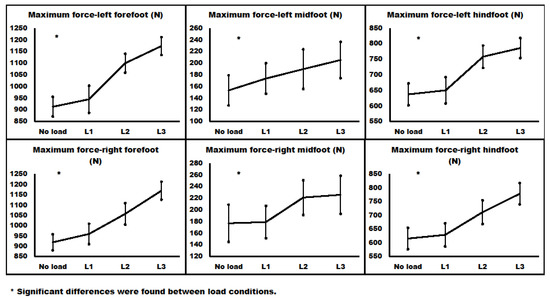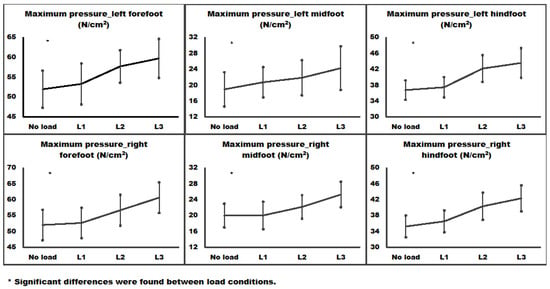Abstract
The main purpose of this study was to examine the effects on gait of carrying different standardized police loads. In this cross-sectional study, we randomly recruited 30 special police officers. Spatiotemporal and kinetic gait changes were evaluated by using the Zebris FDM pressure platform, when load carriage ranged from 5 to 45 kg. Heavier loading conditions significantly increased ground reaction forces and plantar pressures for both feet beneath the forefoot, midfoot, and hindfoot regions of the foot. However, as load increased there were no significant changes in spatiotemporal gait parameters. This study shows that heavier loads carried by special police officers significantly increase ground reaction forces and plantar pressures under different foot regions. Thus, special interventions aiming to lower kinetic gait parameters throughout a different ergonomics and design of standardized equipment should be considered.
1. Introduction
Special police forces are required to carry heavy loads as part of their daily routines [1,2]. Although such loads may have protective effects with regard to specific tasks [1,3], evidence has shown that the load used often exceeds the maximum of 45% body mass [4]. Moreover, the magnitude of absolute load being carried is rapidly increasing [1,3]. This negative trend affects human locomotion, increasing the energy expenditure costs [1,5] and the level of musculoskeletal injuries [2,6]. Indeed, previous work has demonstrated that the most common injuries are related to stress fractures and lower body joints, mainly the hip, knee, ankle, and foot [2].
Carrying high loads can impact the biomechanics of gait. In a recent review looking at the impact of load carriage on military personnel [7], load carriage had no effect on spatiotemporal variables, like step or stride length, cadence, or step width [8,9,10,11], yet the increases in vertical peak forces and pressures in loaded conditions, compared to unloaded conditions, were consistently reported [8,12,13]. It has been hypothesized that military personnel are more experienced in carrying heavy loads and their gait is too robust to be affected by additional loads [14]. On the other hand, additional added mass of the carried load gradually increases the ground reaction forces [13] and plantar pressures [9,12], leading to greater breaking and propulsive forces [8,10,13].
Special police officers often perform physically demanding tasks such as issuing arrest warrants, rural operations, and personal protection, and antiterrorism responses [15]. In addition, special police officers are challenged by performing vigorous physical activities, like running, pulling and pushing, lifting, carrying heavy objects, and negotiating obstacles daily [16]. All these activities are regularly accompanied by even heavier load carriage exceeding >50% of body mass, compared to military personnel [15,17], leading to the conclusion that they walk less and have lower step frequency [18]. Due to biomechanical adaptations under different loading conditions, previous findings based on military personnel may not be applicable to special police officers [7].
Therefore, the main purpose of the study was to examine the effects of load carriage on the spatiotemporal and kinetic gait changes in special police officers. Based on previous findings in military personnel [7], we hypothesized that heavier load carried by special police officers would have no significant effect on spatiotemporal gait changes, yet ground reaction forces and plantar pressures under the different foot regions would steadily increase.
2. Materials and Methods
2.1. Study Participants
For the purpose of this cross-sectional study, we randomly selected 30 full-time special police officers, who were part of the Anti-Terrorist Special Police Unit “Lučko” with more than five years of service. All participants were healthy and without acute or chronic conditions at the time the study was conducted. All participants were males between 28 and 51 years of age (mean ± SD; age = 40 ± 6 years, height = 180.0 ± 5.0 cm, weight = 89.0 ± 8.0 kg) and consented to be in the study. All procedures conducted in this study were anonymous and in accordance with the Declaration of Helsinki [19]. The Ethical Committee of the Faculty of Kinesiology and Lučko approved the study.
2.2. Loading Conditions
During testing, each participant walked over a platform with each of four loads standardized by the Ministry of Internal Affairs for special police officers: (1) body weight only (no load), (2) with a 5-kg load (load 1, belt plus a pistol with a full handgun’s magazine plus an additional full handgun’s magazine plus a nightstick and handcuffs), (3) with a 25-kg load (load 2, load 1 + a helmet plus a fully equipped backpack and a rifle), and (4) with a 45-kg load (load 3, load 1 + load 2 plus a bulletproof vest and night vision goggles). The order of the other load was randomized, to reduce the impact of a learning effect.
2.3. Gait Analysis
To assess spatiotemporal and kinetic parameters of the gait, we used a pressure platform (ZEBRIS company, FDM; GmbH, Munich, Germany; number of sensors: 11,264; sampling rate: 100 Hz; sensor area: 149 cm × 54.2 cm). The assigned protocol has been described previously [20]. In brief, the walkway was 10.5 m in length (1.5-m platform and 4.5-m custom-designed dense material placed before and after the platform). Each participant was instructed to walk at a preferred speed and to look straight forward across the platform, while being barefoot. After the signal, the participants walked from the starting to the finishing line 10.5 m apart, after which they needed to turn around for 180° and continue to walk over the platform until they reached the end of the walkway. The protocol was repeated four times with a total of eight trials across the platform, as recommended by previous studies [21]. The reliability analysis showed a strong intercorrelation between the trials under each loading condition (Cronbach’s α = 0.92–0.97). Once the data collection for each loading condition was complete, the load was removed and the participants were allowed to sit and rest for 3 min between the loading conditions or when heart rate was below 100 beats per minute [22].
2.4. Data Analysis
Basic descriptive statistics are presented as mean and standard deviation (SD). A Kolmogorov–Smirnov test was used to assess the normality of the distribution. The dependent spatiotemporal variables included foot rotation (°, left and right foot), step length (cm, left and right foot), stride length (cm), step width (cm), step time (s, left and right foot), stride time (s), cadence (steps/min), and gait speed (m/s), whereas the kinetic variables included ground reaction forces (N) and plantar pressures (N/cm2) of the left and right foot beneath the hindfoot, midfoot, and forefoot regions. The software generated rotations of both feet by measuring the position of each foot being placed on the platform in the support phase of the gait and comparing the angle of a footprint to platform (which is in line with 0° and 180°). Consequently, the angle between the straight platform line and foot placement serves as the foot rotation. For each participant, the dependent variables were averaged across the eight successful trials and analyzed with one-way repeated measures ANOVA to test the effects of load configuration (no load, load 1, load 2, and load 3). Where significant differences between load configurations were observed, a modified Bonferroni procedure was used. All statistical analyses were performed by using SPSS v23.0 software (IBM, Armonk, NY, USA) with an alpha level set a priori at p < 0.05 to denote statistical significance.
3. Results
Basic descriptive statistics are presented in Table 1.

Table 1.
Basic descriptive statistics of the study participants (N = 30).
Figure 1 shows spatial gait changes under different loading conditions. Heavier loads had no significant time effects on left foot (F1,3 = 1.104, p = 0.351, η2 = 0.031) and right foot rotation (F1,3 = 0.519, p = 0.670, η2 = 0.022), step length of the left foot (F1,3 = 0.376, p = 0.351, η2 = 0.012), step length of the right foot (F1,3 = 0.863, p = 0.463, η2 = 0.030), stride length (F1,3 = 0.534, p = 0.660, η2 = 0.025), and step width (F1,3 = 1.688, p = 0.175, η2 = 0.053).

Figure 1.
Changes in spatial gait parameters under different loading conditions of no load (only body weight), L1 (5 kg load), L2 (25 kg load) and L3 (45 kg load), (N = 30).
Time changes for temporal gait parameters under different loading conditions are presented in Figure 2. Similar to spatial variables, more mass added resulted in nonsignificant time effects for step length of the left foot (F1,3 = 0.467, p = 0.706, η2 = 0.012) and right foot (F1,3 = 1.377, p = 0.254, η2 = 0.045), stride time (F1,3 = 0.958, p = 0.416, η2 = 0.033), cadence (F1,3 = 1.293, p = 0.281, η2 = 0.041), and gait speed (F1,3 = 0.949, p = 0.420, η2 = 0.039).

Figure 2.
Changes in temporal parameters under different loading conditions of no load (only body weight), L1 (5 kg load), L2 (25 kg load) and L3 (45 kg load), (N = 30).
Results in ground reaction forces for forefoot, midfoot, and hindfoot region of both feet are shown in Figure 3. Heavier loading conditions significantly increased ground reaction forces in left forefoot (F1,3 = 31.773, p < 0.001, η2 = 0.506), midfoot (F1,3 = 2.458, p = 0.048, η2 = 0.074), and hindfoot (F1,3 = 18.150, p < 0.001, η2 = 0.368), and in the right forefoot (F1,3 = 24.686, p < 0.001, η2 = 0.444), midfoot (F1,3 = 3.155, p = 0.028, η2 = 0.095), and hindfoot (F1,3 = 14.903, p < 0.001, η2 = 0.323) regions. A post hoc analysis showed that ground reaction forces under different regions of both feet significantly and gradually increased with heavier loads, compared to the no-load condition (p < 0.05).

Figure 3.
Changes in ground reaction forces beneath specific foot regions under different loading conditions of no load (only body weight), L1 (5 kg load), L2 (25 kg load) and L3 (45 kg load), (N = 30).
Finally, Figure 4 presents changes in plantar pressures under forefoot, midfoot, and hindfoot regions of the feet under different loads. Heavier load carriage significantly increased plantar pressures in the left forefoot (F1,3 = 2.549, p = 0.041, η2 = 0.074), midfoot (F1,3 = 2.029, p = 0.050, η2 = 0.050), and hindfoot (F1,3 = 5.207, p < 0.001, η2 = 0.0.147) and in the right forefoot (F1,3 = 2.930, p = 0.037, η2 = 0.085), midfoot (F1,3 = 2.865, p = 0.039, η2 = 0.082), and hindfoot (F1,3 = 4.901, p < 0.001, η2 = 0.133) regions. Similar to ground reaction forces, a post hoc analysis showed that plantar pressures under different regions of both feet significantly and gradually increased with heavier loads, compared to the no-load condition (p < 0.05).

Figure 4.
Changes in plantar pressures beneath specific foot regions under different loading conditions (N = 30).
4. Discussion
The purpose of the study was to examine the effects of load carriage on the spatiotemporal and kinetic gait changes in special police officers. The main findings of the study are: (1) no significant spatiotemporal gait changes are observed, when applying heavier loads, and (2) gait kinetics, mainly ground reaction forces and plantar pressures under the different foot regions significantly increased after heavier loads.
In agreement with several other studies in military personal, our study showed that heavier loads did not have significant effects on spatiotemporal gait variables in special police officers, including step length, stride length, cadence, and step width [8,9,10,11,23,24], irrespective of the load type carried. Most recently, a systematic review by Walsh and Low [7] has suggested that nonsignificant effects may be explained by evenly distributed loads such as body armor vs. loads borne on the back. It Although we found no significant changes in spatiotemporal biomechanics, some variables like stride length and cadence gradually tended to increase with heavier loads, which is in line with previous studies [9,10]. Because special forces are potentially more experienced in heavy load carriage, spatiotemporal structure of walking becomes too robust to be affected by additional heavier loads [14].
Changes in gait kinetics under heavier loading conditions obtained in this study are in line with previous studies [1,4,8,9,10,12,13]. Specifically, both vertical ground reaction forces and plantar pressures under the different foot regions significantly increased with heavier loads. The mechanism underlying this phenomenon is based on the added mass of the carried load, where the associations between the increased forces and loads are proportional [13]. Indeed, previous evidence has shown that the increased ground reaction forces are congruent with the increased plantar pressures associated with carrying additional load [12]. The greater impact forces and plantar pressures beneath the foot regions increase the incidence of load carriage-related injuries [1], leading to greater breaking and propulsive forces during walking [8,10,13]
This study is not without limitations. Although we examined both spatiotemporal and kinetic gait changes under different loads, we did not measure gait kinematics and electromyography properties. A systematic review by Walsh and Low [7] showed that heavier loads significantly increased hip and knee range of motion, hip and knee extension moments, ankle plantar flexion moments, hip, knee, and ankle sagittal power generation and the activity of antigravity and propulsive trunk and leg muscles. Secondly, the participants were instructed to walk at self-selected speed over the platform in laboratory conditions. Most of previous studies conducted among military personnel have used a predetermined speed by using treadmill walking or running modes [7]. It is possible that task-specific walking speed would give different changes in given variables. Thirdly, physical fitness was not assessed as a mediator. A higher level of physical fitness has been suggested as a protective factor between heavier load carriage and gait biomechanics [17]. Fourth, the length of a walkway might be short, causing the speeds to be “clipped”. Fifth, we did not test civilians, so we cannot compare our findings to the general population. Sixth, the load was not tested independently of how it was distributed on the body. Finally, the testing procedure was based on walking barefoot, whereas walking under specific conditions and tasks using insole shoe sensors inside the footwear might have given different results. Thus, future research should focus on examining kinematics, kinetics, and electromyography of the gait under the different loads and tasks in special police officers considering physical fitness/preparedness.
5. Conclusions
This study shows that heavier loads did not lead to greater spatiotemporal gait changes, yet the level of ground reaction forces and plantar pressures significantly increased with mass added in a sample of special police officers. The findings would suggest that spatiotemporal gait patterns of special police officers are too robust to be modified under heavier loading conditions. However, both ground reaction forces and plantar pressures increased with increased load, pointing out that it might be appropriate to consider the tradeoffs between necessary equipment and risk of injury.
Author Contributions
Conceptualization, L.Š.; Methodology, L.Š.; Software, L.Š.; Validation, L.Š.; Formal analysis, A.Š. and L.Š.; Investigation, A.Š. and L.Š.; Data curation, L.Š.; Writing—original draft, L.Š.; Writing—review & editing, L.Š.; Visualization, L.Š.; Supervision, M.K.and D.S.; Project administration, M.K., M.B., D.S., A.Š. and L.Š.; Funding acquisition, M.B. and D.S. All authors have read and agreed to the published version of the manuscript.
Funding
This research received no external funding.
Institutional Review Board Statement
The protocol was approved by the Institutional Ethics Review Board of the Faculty of Kinesiology and the Anti-Terrorist Special Police Unit ‘Lučko’.
Informed Consent Statement
Not applicable.
Data Availability Statement
The datasets used and/or analysed during the current study are available from the corresponding author on reasonable request.
Acknowledgments
We would like to thank all the study participants and the Antiterrorist Unit Lučko for their enthusiastic participation in the study.
Conflicts of Interest
The authors declare no conflict of interest.
References
- Knapik, J.; Harman, E.; Reynolds, K. Load carriage using packs: A review of physiological, biomechanical and medical aspects. Appl. Ergon. 1996, 27, 207–216. [Google Scholar] [CrossRef] [PubMed]
- Orr, R.M.; Johnston, V.; Coyle, J.; Pope, R. Reported Load Carriage Injuries of the Australian Army Soldier. J. Occup. Rehabil. 2014, 25, 316–322. [Google Scholar] [CrossRef] [PubMed]
- Orr, R. The history of the soldier’s load. Aust. Army J. 2010, 7, 67–88. [Google Scholar]
- Andersen, K.A.; Grimshaw, P.N.; Kelso, R.M.; Bentley, D.J. Musculoskeletal lower limb injury risk in army populations. Sports Med. Open 2016, 2, 22. [Google Scholar] [CrossRef]
- Boffey, D.; Harat, I.; Gepner, Y.; Frosti, C.L.; Funk, S.; Hoffman, J. The Physiology and Biomechanics of Load Carriage Performance. Mil. Med. 2018, 184, e83–e90. [Google Scholar] [CrossRef]
- Jennings, B.M.; Yoder, L.H.; Heiner, S.L.; Loan, L.A.; Bingham, M.O. Soldiers with musculoskeletal injuries. J. Nurs. Scholarsh. 2008, 40, 268–274. [Google Scholar] [CrossRef]
- Walsh, G.S.; Low, D.C. Military load carriage effects on the gait of military personnel: A systematic review. Appl. Ergon. 2021, 93, 103376. [Google Scholar] [CrossRef] [PubMed]
- Sessoms, P.H.; Gobrecht, M.; Niederberger, B.A.; Sturdy, J.T.; Collins, J.-D.; Dominguez, J.A.; Jaworski, R.L.; Kelly, K.R. Effect of a load distribution system on mobility and performance during simulated and field hiking while under load. Ergonomics 2019, 63, 133–144. [Google Scholar] [CrossRef]
- Park, H.; Branson, D.; Petrova, A.; Peksoz, S.; Jacobson, B.; Warren, A.; Goad, C.; Kamenidis, P. Impact of ballistic body armour and load carriage on walking patterns and perceived comfort. Ergonomics 2013, 56, 1167–1179. [Google Scholar] [CrossRef]
- Majumdar, D.; Pal, M.S.; Pramanik, A.; Majumdar, D. Kinetic changes in gait during low magnitude military load carriage. Ergonomics 2013, 56, 1917–1927. [Google Scholar] [CrossRef]
- Coombes, J.S.; Kingswell, C. Biomechanical and physiological comparison of conventional webbing and the M83 assault vest. Appl. Ergon. 2005, 36, 49–53. [Google Scholar] [CrossRef] [PubMed]
- Goffar, S.L.; Reber, R.J.; Christiansen, B.C.; Miller, R.B.; Naylor, J.A.; Rodriguez, B.M.; Walker, M.J.; Teyhen, D.S. Changes in Dynamic Plantar Pressure During Loaded Gait. Phys. Ther. 2013, 93, 1175–1184. [Google Scholar] [CrossRef] [PubMed]
- Tilbury-Davis, D.C.; Hooper, R.H. The kinetic and kinematic effects of increasing load carriage upon the lower limb. Hum. Mov. Sci. 1999, 18, 693–700. [Google Scholar] [CrossRef]
- Liew, B.; Morris, S.; Netto, K. The Effect of Backpack Carriage on the Biomechanics of Walking: A Systematic Review and Preliminary Meta-Analysis. J. Appl. Biomech. 2016, 32, 614–629. [Google Scholar] [CrossRef] [PubMed]
- Irving, S.; Orr, R.; Pope, R. Profiling the Occupational Tasks and Physical Conditioning of Specialist Police. Int. J. Exerc. Sci. 2019, 12, 173–186. [Google Scholar] [PubMed]
- Marins, E.; Barbosa, O.; Machado, E.; Orr, R.; Dawes, J.; del Vecchio, F. Profile of self-reported physical tasks and physical training in Brazilian special operations units: A web-based cross-sectional study. Int. J. Environ. Res. Public Health 2020, 17, 7135. [Google Scholar] [CrossRef]
- Davis, M.R.; Easter, R.L.; Carlock, J.M.; Weiss, L.W.; Longo, E.A.; Smith, L.M.; Dawes, J.J.; Schilling, B.K. Self-Reported Physical Tasks and Exercise Training in Special Weapons and Tactics (SWAT) Teams. J. Strength Cond. Res. 2016, 30, 3242–3248. [Google Scholar] [CrossRef]
- Carlton, S.D.; Carbone, P.D.; Stierli, M.; Orr, R.M. The impact of occupational load carriage on the mobility of the tactical police officer. J. Aust. Strength Cond. 2014, 22, 32–37. [Google Scholar]
- World Medical Association. World Medical Association Declaration of Helsinki: Ethical principles for medical research involving human subjects. JAMA 2013, 310, 2191–2194. [Google Scholar] [CrossRef]
- Kasović, M.; Štefan, L.; Borovec, K.; Zvonař, M.; Cacek, J. Effects of Carrying Police Equipment on Spatiotemporal and Kinetic Gait Parameters in First Year Police Officers. Int. J. Environ. Res. Public Health 2020, 17, 5750. [Google Scholar] [CrossRef]
- Van Der Leeden, M.; Dekker, J.H.; Siemonsma, P.C.; Lek-Westerhof, S.S.; Steultjens, M.P. Reproducibility of Plantar Pressure Measurements in Patients with Chronic Arthritis: A Comparison of One-Step, Two-Step, and Three-Step Protocols and an Estimate of the Number of Measurements Required. Foot Ankle Int. 2004, 25, 739–744. [Google Scholar] [CrossRef] [PubMed]
- Seay, J.F.; Fellin, R.E.; Sauer, S.G.; Frykman, P.N.; Bensel, C.K. Lower extremity biomechanical changes associated with symmetrical torso loading during simulated marching. Mil. Med. 2014, 179, 85–91. [Google Scholar] [CrossRef] [PubMed]
- Schulze, C.; Lindner, T.; Woitge, S.; Schulz, K.; Finze, S.; Mittelmeier, W.; Bader, R. Influence of footwear and equipment on stride length and range of motion of ankle, knee and hip joint. Acta Bioeng. Biomech. 2014, 16, 45–51. [Google Scholar] [PubMed]
- Majumdar, D.; Pal, M.S.; Majumdar, D. Effects of military load carriage on kinematics of gait. Ergonomics 2010, 53, 782–791. [Google Scholar] [CrossRef]
Disclaimer/Publisher’s Note: The statements, opinions and data contained in all publications are solely those of the individual author(s) and contributor(s) and not of MDPI and/or the editor(s). MDPI and/or the editor(s) disclaim responsibility for any injury to people or property resulting from any ideas, methods, instructions or products referred to in the content. |
© 2022 by the authors. Licensee MDPI, Basel, Switzerland. This article is an open access article distributed under the terms and conditions of the Creative Commons Attribution (CC BY) license (https://creativecommons.org/licenses/by/4.0/).